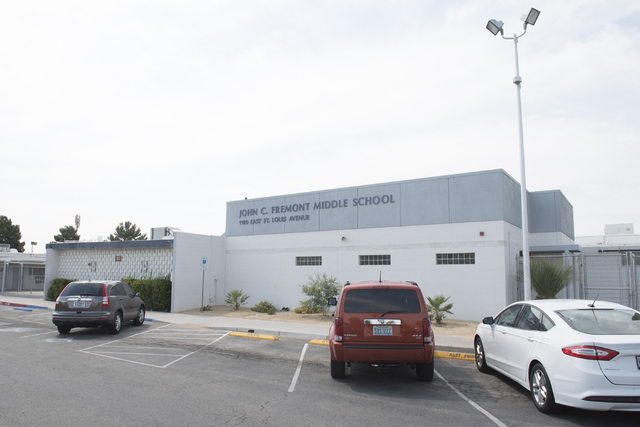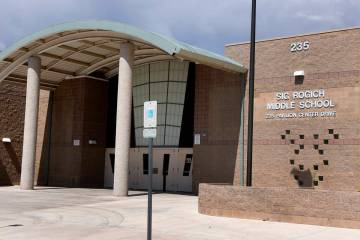Clark County School District teacher hiring campaign hits overdrive
The $10 million that state lawmakers approved to help recruit new teachers may not arrive in Clark County School District coffers for several more weeks.
But that’s not stopping its human resources team from spending June — the most critical hiring month of the year — scouring the nation’s colleges of education for recent graduates, offering accelerated training programs online and even buying an advertisement in Times Square.
With 2,600 teaching positions to fill between February and the start of the school year, their efforts also included hiring four full-time recruiters, creating a new social wellness program to help retain more beginning teachers and hoping tourists haven’t imbibed too much before recruitment commercials play inside area taxicabs.
At first glance, those efforts seem to be paying off.
The district as of last week had hired nearly 1,100 new teachers since April — a 15 percent gain from the same time last year. It now has 1,069 more vacancies to fill before the end of August.
Additionally, fewer new or first-year teachers have left the district, and enrollment in fast-track teacher training more than doubled from 206 in the 2013-14 school year to 472 in the current year.
“Things are going well,” said Staci Vesneske, chief human resources officer for the district.
With a stack of spreadsheets at her side, Vesneske cited figure after figure that suggested a strong return on investment for the $1 million that the district allocated last year to fund an intense hiring campaign.
She specifically highlighted a statistic showing that the district has hired 412 teachers who are new to Clark County but have classroom experience on their résumés. That’s a 150 percent increase from the number of similar hires made this time last year.
“That’s a positive,” Vesneske said. “You want to hire people who have experience.
“That’s due to our advertising efforts, probably due to our weather and a lot of things, but to have that big of an increase, that’s not negligible,” she added. “Had we not done this campaign, I would be very scared.”
HIRING CHALLENGES
Still, Vesneske doesn’t just focus on the positives.
Among the negatives:
■ Nearly a quarter of the teachers hired between April and June have no classroom experience, up from 16.9 percent last year.
■ The number of retirees or teachers leaving for other reasons rose by more than 100.
■ Colleges and universities in Nevada optimistically will produce 1,300 teacher candidates this year.
■ California, which supplies the most out-of-state candidates for the district, anticipates hiring 21,500 teachers statewide — the largest such figure there in a decade.
That’s also not accounting for the intense recruiting efforts of other school districts in Nevada and the rest of the nation, additional positions that the district must fill to satisfy new state mandates and the typical 300 to 400 teachers who will retire or resign before August.
“Let’s see, and we haven’t even mentioned support staff, administrators or substitutes and coaches,” said Meg Nigro, the school district’s executive director of recruitment and development. “Now I’m stressed.”
What troubles Nigro and Vesneske most is the sheer number of vacancies in special education and at-risk elementary schools.
Of the current 1,069 classroom vacancies, more than 850 — or 80 percent — impact the neediest students in first through fifth grade and in special education.
“When people think about vacancies, it should be a concern,” Vesneske said. “It’s certainly a concern for us, but I think it’s important to know the vacancies are not evenly spread. It’s so heavily skewed.”
Cue the state incentives.
In the final moments of their recently concluded session, lawmakers approved Senate Bill 511 to offer $10 million each year over the next two years in local incentives for newly hired teachers to work in at-risk and poorly performing schools.
Districts have until July 6 to submit an application for those funds, with a cap of $5,000 per individual per year, and the State Board of Education will make an initial decision on allocations at its July 23 meeting. Local school boards can decide to use the money for signing bonuses, salary increases and more.
“Even though it won’t be available soon, we are already advertising that about $4,000 to $5,000 will be available,” Vesneske said, adding that some recently hired teachers already have asked about the incentives.
FILLING THE GAPS
Other third-party organizations also have tried to help the district chip away at its overall hiring goal.
Teach for America, a nonprofit group that places recent college graduates at needy schools for two years, extended its contract with the district in December to expand local membership from 150 new teachers to 175 new teachers annually over the next three years.
Nationally, though, a hiccup in the group’s own recruitment efforts has drawn a smaller pool of applicants, and Teach For America will place 115 teachers in Clark County schools this year.
Meanwhile, at Fremont Middle School near Charleston Boulevard and Maryland Parkway, education professors from the University of Nevada, Las Vegas have hosted an intense, five-week teacher training program for an inaugural class of 20 professionals with backgrounds in the military, hospitality, engineering and culinary arts.
The so-called Rebel Academy, which enrolled about six dozen middle school students for free summer courses, offers the 20 teacher candidates a chance to earn enough classroom experience to apply for a teaching license. The candidates will continue their studies at UNLV to complete a master’s degree while teaching full time in the district.
“It’s something that’s always been in my DNA,” said Bentley McDonald, a 27-year-old community organizer who created the local nonprofit Real Education Matters to inspire minority students to care more about school.
While he has heard of the teacher incentives available soon through the state, McDonald said that’s not why he hopes to work at an at-risk middle school starting in August.
“That’s where you can make the greatest impact on a community,” he said. “They do have great incentives, but for me it’s not about the money.”
Contact Neal Morton at nmorton@reviewjournal.com or 702-383-0279. Find him on Twitter: @nealtmorton






































